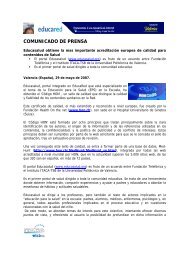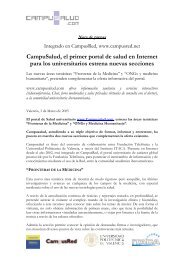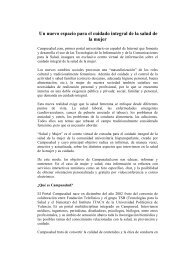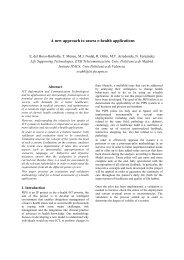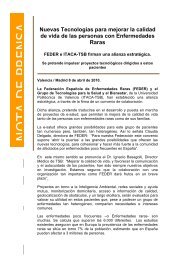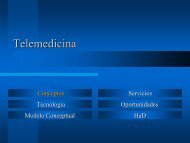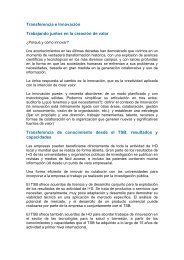Wireless Sensor Networks in Ambient Intelligence - TSB - UPV
Wireless Sensor Networks in Ambient Intelligence - TSB - UPV
Wireless Sensor Networks in Ambient Intelligence - TSB - UPV
You also want an ePaper? Increase the reach of your titles
YUMPU automatically turns print PDFs into web optimized ePapers that Google loves.
<strong>Wireless</strong> <strong>Sensor</strong> <strong>Networks</strong> <strong>in</strong> <strong>Ambient</strong> <strong>Intelligence</strong>Luis Fernández (luiferlu@itaca.upv.es), José M. Blasco (joblabuc@eln.upv.es), José F. Hernández(johercu1@itaca.upv.es) , Eduardo Montón (edmonsan@itaca.upv.es)Technologies for Health and Well-be<strong>in</strong>gInstituto ITACAUniversidad Politécnica de ValenciaAbstractThe <strong>Wireless</strong> <strong>Sensor</strong> <strong>Networks</strong> (WSN) is anecessary technology for the development of theconcept of <strong>Ambient</strong> <strong>Intelligence</strong> where users areprovided of services depend<strong>in</strong>g on their context.The WSNs provide the dynamic and flexiblestructure for the transmission of data acquired fromthe environment by the sensors. This data is thebase for the development of ambient <strong>in</strong>telligentservices adapted with the <strong>in</strong>formation acquiredfrom the sensors. In addition, the same WSNmakes possible the communication with actuatorswith possibilities of perform<strong>in</strong>g physical changes <strong>in</strong>the environment.Keywords<strong>Wireless</strong> <strong>Sensor</strong> <strong>Networks</strong>, <strong>Wireless</strong> Body Area<strong>Networks</strong>, Zigbee, <strong>Ambient</strong> <strong>Intelligence</strong>.1. IntroductionThe concept of <strong>Ambient</strong> <strong>Intelligence</strong> (AmI) is thenew paradigm for provid<strong>in</strong>g future applications <strong>in</strong>the Information Society, hid<strong>in</strong>g the complexity ofthe technology, offer<strong>in</strong>g the <strong>in</strong>telligent servicesdepend<strong>in</strong>g on the context of the user and throughnatural <strong>in</strong>terfaces. For the development of thisconcept it is necessary to gather <strong>in</strong>formation aboutthe user and the environment <strong>in</strong> order to be able ofknow<strong>in</strong>g the context of the mentioned user. TheWSN addresses this necessity provid<strong>in</strong>g a wirelessand flexible structure for the transmission of thedata acquired by sensors to a system <strong>in</strong> charge ofprocess<strong>in</strong>g this <strong>in</strong>formation. In addition, it is alsopossible to use these type of networks tocommunicate with actuators that make actions <strong>in</strong>the environment of the user.2. Features of <strong>Wireless</strong> <strong>Sensor</strong> <strong>Networks</strong>The pr<strong>in</strong>cipal feature of a WSN is to transmitwirelessly the data, acquired by sensors <strong>in</strong> differentenvironments, to the elements (<strong>in</strong> the same networkor <strong>in</strong> other) <strong>in</strong> charge of process<strong>in</strong>g this<strong>in</strong>formation.Usually these networks are composed by a greatnumber of nodes. This means that somecharacteristics as small size, low powerconsumption, low complexity and low cost aredesirable goals when design<strong>in</strong>g a WSN.Us<strong>in</strong>g a system that needs the batteries to becharged every day can become a quite annoy<strong>in</strong>gtask if the number of devices is quite high. Inaddition if each device <strong>in</strong> the system is complex asmuch to design as to manufacture, this system isnot go<strong>in</strong>g to be cost-effective to the market. Forthis reasons users expect batteries to last months toyears, and designers expect a simple technologywhich implies quick and simple designs <strong>in</strong> order toget globally standard cheap systems.Every technology, protocol and topology designedfor and related to WSN must take <strong>in</strong>to accountthese characteristics. Protocols must ensure thenodes to realize simple tasks <strong>in</strong> order to simplifytheir functionality and they must ensure too that thetransmitters and receivers works the m<strong>in</strong>imumpossible time <strong>in</strong> order to reduce powerconsumption and <strong>in</strong>crease <strong>in</strong> this way the batterylife, and, of course, everyth<strong>in</strong>g must be done at aprice that allows an affordable cost for a networkthat <strong>in</strong>tegrates a high density of nodes.A. TopologiesIn the wide range of scenarios for WSN, it isimpossible that one network topology could resolveoptimally all the requirements, so there aredifferent topologies [1, 2] for different scenarios.Two are the ma<strong>in</strong> topologies used <strong>in</strong> WSN:• Start Network• Mesh NetworkThe star topology is useful <strong>in</strong> WSN, especially <strong>in</strong>the development of <strong>Wireless</strong> Body Area <strong>Networks</strong>,WBAN. In this topology, a central node has the
esponsibility of the coord<strong>in</strong>ation with the medicalsensors and the communication outside the BAN.or process<strong>in</strong>g the sensor data. This topology is usedwhen the sensors are located <strong>in</strong> a wide area.The current developments <strong>in</strong> WSN are also focusedon mesh network topology because it allows for thecommunication between devices without a centralnode for rout<strong>in</strong>g us<strong>in</strong>g a mesh of nodes. Thisfeature elim<strong>in</strong>ates the central failure, and providesself-heal<strong>in</strong>g and self-organization. The selforganization provides more robustness than a statictopology, and allows hav<strong>in</strong>g mobile devices. Forprovid<strong>in</strong>g this functionality, the current research iswork<strong>in</strong>g <strong>in</strong> new algorithms and optimiz<strong>in</strong>galgorithms, for self-rout<strong>in</strong>g and giv<strong>in</strong>g <strong>in</strong>telligenceto the nodes.Star network: <strong>in</strong> this case the network is formed bya central element, <strong>in</strong> charge of controll<strong>in</strong>g thenetwork, which receives the <strong>in</strong>formation fromwireless sensor end-po<strong>in</strong>t nodes. These arephysically similar to the mesh network nodes. Theend-po<strong>in</strong>t nodes send data directly to the centralcoord<strong>in</strong>ator. From there, data is relayed to othersystems. Star networks offer the fastest datagather<strong>in</strong>g speed. The star network topology istypically used <strong>in</strong> Body Area <strong>Networks</strong> (BAN), alsocalled Body <strong>Sensor</strong> Network (BSN) [3], wheresensors are located on the body of a person.Figure 2. Mesh WSN topologyIn both cases, it is usual to have a gateway tocommunicate with other local or wide areanetworks. In the case of a mesh network this taskcan be performed by one or several of the nodeswhich would have additional electronics and, <strong>in</strong> thecase of the star network, the network coord<strong>in</strong>ator is<strong>in</strong> charge of this task.B. <strong>Wireless</strong> Technologies & ProtocolsThe development and standardization of new lowpower consumption and short range wirelesstechnologies have enabled the wireless sensornetwork concept. Today, there are several optionsfor the development of WSN. These technologiesspecify the Physical and MAC levels (ex., IEEE802.15.4), the Network levels (ex., Zigbee) or thethree levels <strong>in</strong> the same specification (ex.,Bluetooth). There is also one special OperativeSystem developed to run <strong>in</strong> the nodes of a <strong>Wireless</strong><strong>Sensor</strong> Network, this Operative System is calledT<strong>in</strong>yOS [4].Figure 1. Start WSN topologyMesh network: it is formed of several modules,usually consist<strong>in</strong>g of a battery, RF adapter,microcontroller, and sensor board, although not allthe nodes <strong>in</strong>clude sensors. Each wireless node actsas a router, send<strong>in</strong>g and receiv<strong>in</strong>g data from othersensors or the gateway. Self-organiz<strong>in</strong>g networksautomatically determ<strong>in</strong>e the best path for data totake from sensor to gateway. Data is automaticallysent around failed sensor routers. Because of thelimitations, due to battery life, nodes are built withpower conservation <strong>in</strong> m<strong>in</strong>d, and generally spendlarge amounts of time <strong>in</strong> a low-power "sleep" mode802.15.4The scope of IEEE 802.15.4 task group [5, 6], asdef<strong>in</strong>ed <strong>in</strong> its orig<strong>in</strong>al Project AuthorizationRequest, is “to def<strong>in</strong>e the PHY and MACspecifications for low data rate wirelessconnectivity with fixed, portable and mov<strong>in</strong>gdevices with no battery or very limited batteryconsumption requirements”. Furthermore, thepurpose of the specification is “to provide astandard for ultra low complexity, ultra low cost,ultra low power consumption and low data ratewireless connectivity among <strong>in</strong>expensive devices”.The characteristics of 802.15.4 make this
technology one of most <strong>in</strong>terest<strong>in</strong>g for thedevelopment of BAN [7].IEEE 802.15.4 is specified to work <strong>in</strong> threedifferent sub-bands of the ISM band (2.4 GHz, 915MHz <strong>in</strong> USA and 868 MHz <strong>in</strong> Europe), withthroughputs of 250 kbps, 40 kbps and 20 kpbsrespectively. Although the higher frequency makesthat for a power transmission given, the range isshorter, this is one of the unlicensed band, moreexpanded <strong>in</strong> the world.Channel access is contention based, via a carriersense multiple access mechanism with collisionavoidance (CSMA-CA). A “battery life extension”mode is also available the period of transmission toa fixed time of approximately 2 ms.IEEE 802.15.4 specifies the physical layer andportions of the data l<strong>in</strong>k layer (DLL). The higherlayerprotocols are left to <strong>in</strong>dustry (Zigbee) and the<strong>in</strong>dividual applications.Table 1. IEEE 802.15.4 <strong>in</strong> the ISO-OSI layerednetwork modelISO-OSI Model IEEE 802 Model7. Application6. Presentation5. Session4. Transport3. Network2. Data l<strong>in</strong>k1. PhysicalIEEE 802.2LLC, type ISSCSHigher layersOther LLCIEEE 802.15.4 (MAC)IEEE802.15.4868/915 MHz(PHY)IEEE802.15.4 2.4GHz (PHY)ZigbeeThe Zigbee Alliance [8] is an IndustrialConsortium of chip manufacturers, OEMmanufactures, service providers, and users <strong>in</strong> thewireless sensor network market. This Consortiumis carry<strong>in</strong>g out the task of association of specify<strong>in</strong>ghigher-layer standards, based on IEEE 802.15.4.This <strong>in</strong>cludes network, security, and applicationprotocols.The Zigbee standard specifies both mesh and starnetwork topologies. There are two physical devicetypes for the lowest system cost to allow vendors tosupply the lowest possible cost devices: fullfunction devices and reduced function devices.• Full function device (FFD):o Can function <strong>in</strong> any topology.o Capable of be<strong>in</strong>g the Networkcoord<strong>in</strong>ator.o Can talk to any other device.• Reduced function device (RFD).o Limited to star topology.o Cannot become a network coord<strong>in</strong>ator.o Talks only to a network coord<strong>in</strong>ator.o Very simple implementation.Zigbee is an <strong>in</strong>cipient standard that covers thenecessities of the network layer <strong>in</strong> the wirelesssensor networks, supported by importantcompanies like Philips, Samsung, Motorola,Mitsubishi Electric, Cisco Systems, Epson, etc.BluetoothBluetooth (BT) [9] is a radio wave basedtechnology for short-range wireless connectivityamong portable and/or fixed electronic devices,such as cellular phones, headsets, personal digitalassistants and laptops, as well as for theirconnectivity to the Internet. The BT specificationconsists of the core and the profile part: the corepart def<strong>in</strong>es how the BT technology works and theprofile part describes how the BT technology isused <strong>in</strong> specific scenarios and use cases. Thestandard specifies from the physical to theapplication layer.Radio frequency operation is <strong>in</strong> the unlicensedIndustrial, Scientific and Medical (ISM) band at2.4 to 2.48 GHz, us<strong>in</strong>g a spread spectrum,frequency hopp<strong>in</strong>g, full-duplex signal at up to 1600hops/sec. The signal hops among 79 frequencies at1 MHz <strong>in</strong>tervals, to give a high degree of<strong>in</strong>terference immunity. RF output is specified forthree different types:• 0 dBm (1 mW) for a communication range ofless than 5 m.• 4 dBm (2.5 mW) for a communication rangeof 10-20 m.• +20 dBm (100 mW) for a communicationrange of around 100 m.The Bluetooth 1.1 specification def<strong>in</strong>es a lowpowerradio l<strong>in</strong>k capable of voice or datatransmission to a maximum capacity of 720 kbpsper channel.The IEEE 802.15.1 Group Task [10] provided astandard adaptation of the Bluetooth Specification
v1.1 Foundation MAC (L2CAP, LMP, andBaseband) and PHY (Radio).The use of Bluetooth, although more extended thatZigbee is more focused on the personalcommunications and essential problems, like thepower consumption or the synchronization <strong>in</strong> theBAN, could not be managed with this technology.UltraWideBandUltra-Wideband (UWB) technology has theobjective of provid<strong>in</strong>g the convenience andmobility of wireless communications, to highspeed<strong>in</strong>terconnect devices throughout the digitalhome and office. Designed for short-range,wireless personal area networks (WPANs), UWBwants to become the lead<strong>in</strong>g technology for free<strong>in</strong>gpeople from wires, enabl<strong>in</strong>g wireless connection ofmultiple devices for transmission of video, audioand other high-bandwidth data.UWB, short-range radio technology, complementsother longer range radio technologies, such asWiFi, Wi-Max, and cellular wide areacommunications. It is used to relay data from a hostdevice to other devices <strong>in</strong> the immediate area (up to10 meters).A traditional UWB transmitter works by send<strong>in</strong>gbillions of pulses across a very wide spectrum offrequencies, several GHz <strong>in</strong> bandwidth. Thecorrespond<strong>in</strong>g receiver then translates the pulses<strong>in</strong>to data by listen<strong>in</strong>g for a familiar pulse sequence,sent by the transmitter. Specifically, UWB isdef<strong>in</strong>ed as any radio technology hav<strong>in</strong>g a spectrumthat occupies a bandwidth greater than 20 percentof the centre frequency, or a bandwidth of at least500 MHz.Modern UWB systems use other modulationtechniques, such as Orthogonal Frequency DivisionMultiplex<strong>in</strong>g [11] (OFDM), to occupy theseextremely wide bandwidths. In addition, the use ofmultiple bands <strong>in</strong> comb<strong>in</strong>ation with OFDMmodulation, can provide significant advantages totraditional UWB systems.UWB's comb<strong>in</strong>ation of broader spectrum and lowerpower improves speed and reduces <strong>in</strong>terferencewith other wireless spectra. In the United States,the Federal Communications Commission (FCC)has mandated that UWB radio transmissions canlegally operate <strong>in</strong> the range from 3.1 GHz up to10.6 GHz, at a limited transmit power of -41dBm/MHz. Consequently, UWB providesdramatic channel capacity at short range, that limits<strong>in</strong>terference.In June 2003, the MultiBand OFDM Alliance(MBOA) was formed, with many of the most<strong>in</strong>fluential players <strong>in</strong> the consumer electronics,personal comput<strong>in</strong>g, home enterta<strong>in</strong>ment,semiconductor, and digital imag<strong>in</strong>g marketsegments. The goal of this organization is todevelop the best technical solution for theemerg<strong>in</strong>g UWB (IEEE 802.15.3a Task Group [11])Physical and MAC specification for a diverse set ofapplications. To date, MBOA has more than 60participants that support a s<strong>in</strong>gle technical proposalfor UWB.UWB is a technology <strong>in</strong> the physical level of theOSI stack. There are protocols as Bluetooth,Zigbee, USB [12] that are study<strong>in</strong>g to <strong>in</strong>cludeUWB <strong>in</strong> theirs physical layers.This new technology is be<strong>in</strong>g studied is severalprojects for the development of WBAN [13, 14,15].Table 2. <strong>Wireless</strong> Technologies for WSNZigbee Bluetooth UWBRange Up to 100m Up to 100m Up to 10mThroughput 250 kbps 720 kbpsTransmission levelsPHY/MAClevelsNetworkleveldef<strong>in</strong>itionOEMmodules <strong>in</strong>the market0 dBmIEEE802.15.4Yes(Piconet,Scatternettopologies)IncipientpenetrationSoftware, T<strong>in</strong>yOS0 dBm, 4dBm or 20dBmIEEE802.15.1Yes (Mesh,Startopologies)Highpenetration480 Mbps(10 m.)100 Mbps(3 m.)-41dBm/MHzIEEE802.15.3aNoLowpenetrationT<strong>in</strong>yOS [4] is an open-source operat<strong>in</strong>g system,designed for wireless embedded sensor networks. Itfeatures a component-based architecture, aimed atenabl<strong>in</strong>g rapid <strong>in</strong>novation and implementationwhile m<strong>in</strong>imiz<strong>in</strong>g code size, as required by thesevere memory constra<strong>in</strong>ts <strong>in</strong>herent <strong>in</strong> sensornetworks. T<strong>in</strong>yOS's component library <strong>in</strong>cludesnetwork protocols, distributed services, sensordrivers, and data acquisition tools -all of which canbe used as- is or be further ref<strong>in</strong>ed for a customapplication. T<strong>in</strong>yOS's event-driven executionmodel enables f<strong>in</strong>e-gra<strong>in</strong>ed power management, yet
allows the schedul<strong>in</strong>g flexibility made necessary bythe unpredictable nature of wireless communicationand physical world <strong>in</strong>terfaces.T<strong>in</strong>yOS has been ported to over a dozen hardwareplatforms and numerous sensor boards. A widecommunity uses it <strong>in</strong> simulation, to develop andtest various algorithms and protocols. New releasessee over 10,000 downloads. Over 500 researchgroups and companies are us<strong>in</strong>g T<strong>in</strong>yOS on theBerkeley/Crossbow Motes. Numerous groups areactively contribut<strong>in</strong>g code to the sourceforge siteand work<strong>in</strong>g together to establish standard,<strong>in</strong>teroperable network services, built from a base ofdirect experience and honed through competitiveanalysis <strong>in</strong> an open environment.3. WSN nodesThe pr<strong>in</strong>cipal device <strong>in</strong> a WSN is the networknode, also called mote. This device, batterypowered, has the RF communication for thetransmission and the reception of the <strong>in</strong>formation,an <strong>in</strong>terface between the module and the sensor anda microcontroller.Normally this microcontroller is a simple 8-bitmicrocontroller. S<strong>in</strong>ce, as commented above, oneof the ma<strong>in</strong> goals when design<strong>in</strong>g nodes <strong>in</strong> WSN issimplicity, this k<strong>in</strong>d of processors must be enoughpowerful to manage communications, and their lowclock frequencies reduce power consumption, thus<strong>in</strong>creas<strong>in</strong>g the battery life.Depend<strong>in</strong>g on the size and shape requirements,batteries will be a key factor <strong>in</strong> the design of thenodes. Normally batteries are the bottleneck of thedesign when referr<strong>in</strong>g to size. The higher thecapacity of the battery is needed the bigger the sizeis. A trade off between these two parameters mustbe done. Plenty of commercial batteries areavailable <strong>in</strong> the market: Lithium-Ion rechargeablebatteries, small co<strong>in</strong> batteries, high capacity Ni-Cdbatteries, etc…Regard<strong>in</strong>g the transceivers for the RF part of thedevice, normally similar options are available fromdifferent manufacturers. This allows the designersto choose between different prices andcharacteristics depend<strong>in</strong>g on the needs of eachdesign.In the tables 4 and 5 a list with the commercialmodules available <strong>in</strong> the market and theirscharacteristics is <strong>in</strong>cluded.
Table 4. Commercial Modules for WSNDescriptioniMote2 iMote MicaZ TelosB MICA2DOT(MPR500CA)Intel low power wirelesssensor moduleIntel low powerwireless sensormoduleLow Power <strong>Wireless</strong><strong>Sensor</strong> ModuleLow Power<strong>Wireless</strong> <strong>Sensor</strong>Module withUSBSmall Size Low Power<strong>Wireless</strong> <strong>Sensor</strong>Module (no 802.15.4)Mica2Low Power <strong>Wireless</strong> <strong>Sensor</strong>Module (no 802.15.4)Operative System T<strong>in</strong>yOS T<strong>in</strong>yOS T<strong>in</strong>yOS T<strong>in</strong>yOS T<strong>in</strong>yOS T<strong>in</strong>yOSCompany Intel Intel Xbox XBOX XBOX XBOXData Rate 250Kbps 720kbps 250kbps 250 kbps FSK data rate up to76.8 kBaudRF transceiverBluetooth CC2420 CC2420 cc1000 cc1000FSK data rate up to 76.8kBaudChipCon CC2420Frequency 2,4 GHZ 2,4GHz 2,4GHz 2,4 Ghz 868/916MHz, 868/916MHz, 433MHz or433MHz or 315MHz multi-channel315MHz multichannelMicrocontroller Intel® PXA 271 Atmega128L, 8 MHz Atmega128L, 8 TI MSP430 ATmega128L ATmega128LXscale®MHzPowerRequirementsCurrentdeployment stateUltra low voltage at lowspeeds (0.85V up to 104MHz)Deep sleep (0.1mW)Deep sleep 1 uA 8 mA (active);
Table 5. Commercial Modules for WSNTelosA tmoteSky EM250 EM260 CC2430Description Low Power <strong>Wireless</strong> Low Power <strong>Wireless</strong> Chip with Chip with ZigBee Chip with ZigBee<strong>Sensor</strong> Module with <strong>Sensor</strong> Module with ZigBee System-on-Chip (micro System-on-Chip (microUSB (discont<strong>in</strong>ued), USBSystem-on- and transceiver) - and transceiver) -new version calledChip (micro EmberZNet Stack (mesh ZigBee protocol stacktmoteSkyandNW <strong>in</strong>cluded) (Z-Stack)transceiver)Operative T<strong>in</strong>yOS T<strong>in</strong>yOS Custom Custom Custom (Airbee)SystemCompany Moteiv - Moteiv Ember Ember ChipconData Rate 250kbps 250kbps 250kbps 250kbps 250kbpsRF transceiver CC2420 CC2420 Custom Custom cc2030Frequency 2,4Ghz 2,4Ghz 2,4Ghz 2.4Ghz 2,4GhzMicroControladorTI MSP430 TI MSP430 embedded 16-bit XAP2microcontroller16MHz8051 8-bit s<strong>in</strong>gle-cyclemicrocontrollerPowerRequirementsCurrentdeploymentstate19 mA (active- radio 19 mA (active- radio 1uA max (deep 1uA max (deep sleep), RX +CPU->27 mA, 0.6on), 2.4 uA (sleep) on), 5 uA (sleep) sleep), 29mA 26mA (RX+CPU) uA sleep<strong>in</strong>g(RX+CPU)Discont<strong>in</strong>ued on sale pre-order pre-order Pre-order
4. <strong>Wireless</strong> <strong>Sensor</strong> <strong>Networks</strong>ApplicationsThe number of potential applications of sensornetwork technology is grow<strong>in</strong>g all the time.Applications of WSN technology <strong>in</strong>clude:• Remote Control and Monitor<strong>in</strong>g <strong>in</strong> <strong>in</strong>dustrialSystem• Home Automation and Security• Inventory and Logistic• Natural Environment Monitor<strong>in</strong>g• Agriculture• Human Interface Devices• Military Monitor<strong>in</strong>g• Health Monitor<strong>in</strong>g [16] (i.e.BAN)• Etc.The follow<strong>in</strong>g table <strong>in</strong>cludes a table of <strong>Wireless</strong><strong>Sensor</strong> <strong>Networks</strong> projects developed <strong>in</strong> theEuropean Union (Body Area <strong>Networks</strong> are not<strong>in</strong>cluded).Table 3. Mesh <strong>Networks</strong> projectsName Description WebWiSeNts Cooperat<strong>in</strong>g EmbeddedSystemsforExploration andControl featur<strong>in</strong>g<strong>Wireless</strong> <strong>Sensor</strong><strong>Networks</strong>EYES self-organiz<strong>in</strong>g andcollaborative energyefficientsensornetworksHogthrob Networked on-a-chipnodes for sowmonitor<strong>in</strong>gIntairner Intelligent AirMonitor<strong>in</strong>g Networkfor monitor<strong>in</strong>g thequality of the air.LakeNet Embedded <strong>Sensor</strong>Network forEnvironmentalMonitor<strong>in</strong>gRUNES ReconfigurableUbiquitous NetworkedEmbedded Systemswww.embedded-wisents.org/www.eyes.eu.orgwww.hogthrob.dkwww.nd.edu/~lemmon/lakenetproject/lakenet.htmlwww.istrunes.org/SPOTDTS/SNADAOptimaGoodFoodtechniques for securelocalization of wirelessdevices <strong>in</strong> sensornetworksDelay Tolerant<strong>Networks</strong> / <strong>Sensor</strong><strong>Networks</strong>Advanced DistributedNetwork forTelemonitor<strong>in</strong>gServices, Air QualityMonitor<strong>in</strong>g<strong>Wireless</strong> <strong>Sensor</strong>Network for thelocalization of patients<strong>in</strong> a hospitalenvironment us<strong>in</strong>gBluetoothWSNs for Food Safetyand Quality Monitor<strong>in</strong>gBody Area <strong>Networks</strong>http://imm.dtu.dk/sens/secloc.htmlhttp://www.sics.se/cna/dtnsn/<strong>in</strong>dex.htmlwww.ada-ist.org/http://ami.goodfood-project.orgOne special case of WSN is the Body AreaNetwork (BAN). A BAN has compact units whichenable transfer vital signs from the body of the userbetween the user’s location and the cl<strong>in</strong>ic or thedoctor. There are a lot of projects that use BAN formonitor<strong>in</strong>g the state of the patients.This section gathers some relevant examples ofprojects related with BAN technologies and acomparison of their characteristics.SensationSENSATION, an European project, researchesmicro and nano sensor technologies with the goalof monitor<strong>in</strong>g, detect<strong>in</strong>g and predict<strong>in</strong>g the humanphysiological state <strong>in</strong> relation to its alertness,fatigue and stress at anytime, <strong>in</strong> anyplace and foreveryone.Web Site: http://www.sensation-eu.org/<strong>in</strong>dex.htmlMobiHealthThe MobiHealth European project has developed acustomisable monitor<strong>in</strong>g system for vital signals,based on a BAN [17] and an m-health serviceplatform, utiliz<strong>in</strong>g UMTS and GPRS networks. The
prototype <strong>in</strong>cludes Bluetooth for thecommunication <strong>in</strong>traBAN and the central device isa PDA.Web Site: http://www.mobihealth.org/VitaSensVitaSens [18] is a wireless Body Area Network,developed by the Fraunhofer Institute forIntegrated Circuits <strong>in</strong> Germany. The BANdeveloped <strong>in</strong>cludes ECG, PSO2, temperature,blood pressure and respiratory sensors. The firstprototype has been developed us<strong>in</strong>g Bluetooth forthe communication between sensors and the centralunit, whereas -currently - is be<strong>in</strong>g adapted to -Zigbee for this communication.Web Site: http://www.ban.fraunhofer.de/Human++Human++ project of the InteruniversityMicroElectronics Centre of Belgium is develop<strong>in</strong>ga WBAN [15]. The objectives of the research<strong>in</strong>cludes Micro-Power generation (vibrational andthermal scavenger) for <strong>in</strong>creas<strong>in</strong>g the lifetime ofbattery-powered devices, 4ltra low-power radios,us<strong>in</strong>g UWB (IEEE 802.15.4a), Biosensors (DNAsensors), MEMS, EEG, etc.Web Site: http://www.imec.be/human/UbimonUbimon [19] is a research project, aimed at thedevelopment of an Ubiquitous Monitor<strong>in</strong>gEnvironment for Wearable and Implantable<strong>Sensor</strong>s. This project has developed a BSN,<strong>in</strong>clud<strong>in</strong>g ECG, SPO2, accelerometer, temperatureand humidity sensors. In this research, a RFmodulehas been developed, based on IEEE802.15.4 technology (CC2420 RF transceiver), theT<strong>in</strong>yOS and the transceiver CC2420. A CompactFlash-802.15.4 has been developed for PDAs andalso software for Data M<strong>in</strong><strong>in</strong>g.Web Site:http://www.doc.ic.ac.uk/vip/ubimon/home/<strong>in</strong>dex.htmlCodeblueThe University of Harvard <strong>in</strong> USA is carry<strong>in</strong>g outthe Codeblue project [20]. This project is explor<strong>in</strong>gapplications of wireless sensor network technologyto a range of medical applications, <strong>in</strong>clud<strong>in</strong>g prehospitaland <strong>in</strong>-hospital emergency care, disasterresponse, and stroke patient rehabilitation, andlocalization with RF (MoteTrack Project). Thema<strong>in</strong> development of this project is a WBAN withbattery-powered "motes” and medical sensors(ECG, SPO2, Motion, EMG). The RF technologyis based on the 802.15.4 standard, T<strong>in</strong>yOS andMica and Telos modules.Web Site:http://www.eecs.harvard.edu/~mdw/proj/codeblue/PRIMA: Portable Remote Intelligent MedicalAgentsThe PRIMA project of the University of Galway <strong>in</strong>Ireland is focused on the research, design, andevaluation of a prototype <strong>in</strong>telligent agent basedsystem for portable/remote monitor<strong>in</strong>g andmanagement of at cardiac risk patients. In thisproject a WBAN, with an ECG smart sensor,Neural <strong>Networks</strong>, and RF localization us<strong>in</strong>gBluetooth, has been developed. At the end of thePRIMA project, a sp<strong>in</strong>-off called Syncrophi hasstarted the project BIOSENSE . In this project aWBAN us<strong>in</strong>g Zigbee will be developed.Web Site:http://ecrg.it.nuigalway.ie/projects/prima.htmlWBAN-ETHThis project, of the Swiss Federal Institute ofTechnology of Zurich, is develop<strong>in</strong>g a <strong>Wireless</strong>Body Area Network [14] of non-<strong>in</strong>vasive sensorswith energy efficiency, unobtrusiveness, scalabilityand cost structure. The RF technology is UltraWide Band, from 3 to 6 GHz, and the current workis focused on the effects of body block<strong>in</strong>g withUWB. The objective of the project is to support ahigh density of heterogeneous nodes (about 50 perbody).Web Site:http://www.nari.ee.ethz.ch/wireless/research/projects/ban.htmlBasuma: Body Area System for UbiquitousMultimedia ApplicationsThis project is funded by the German Government,with the collaboration of universities and PhilipsResearch. They are develop<strong>in</strong>g a wireless BAN thatallows for monitor<strong>in</strong>g heart rate, blood pressure,etc. The BAN should be able to make <strong>in</strong>telligentdecisions about the state of health and send the<strong>in</strong>formation to the medical services. It is ma<strong>in</strong>lybased upon UWB technology.Web Site: http://www.basuma.deMOTETRACKThis project has been developed <strong>in</strong> the Universityof Harvard (USA). In this project has beendeveloped a RF-based location track<strong>in</strong>g system. Itis based on low-power radio transceivers coupledwith a modest amount of computation and storage
capabilities, such as the Berkeley Mica2 sensor“mote.” The source code for the modules isavailable on the web.Web Site:http://www.eecs.harvard.edu/~konrad/projects/motetrack/WBAN-AlabamaA research group <strong>in</strong> the University of Alabama <strong>in</strong>Huntsville, USA, has developed a wireless BAN of<strong>in</strong>telligent motion sensors for computer assistedphysical rehabilitation, us<strong>in</strong>g 802.15.4 modules,Telos, and T<strong>in</strong>yOS. This group has also developedWBANs, with ECG, SPO2 and breath<strong>in</strong>g sensors.Web Site: http://www.ece.uah.edu/~jovanov/Healthy-AimsHealthy Aims is an IP project, aimed at thedevelopment of <strong>in</strong>telligent medical implantssensors, functional electrical stimulation, humanbody motion sensors, etc. In this project a bodyarea network has been developed, enabl<strong>in</strong>gcommunication from implants on the body devicesto a base unit, which may be up to 3 m. away,us<strong>in</strong>g implantable power sources, biomaterials andRF technologies for implantable devices.Web Site: http://www.healthyaims.org/MyHeartThe European IP project MyHeart is develop<strong>in</strong>g aBody Area Network us<strong>in</strong>g smart-clothes. It<strong>in</strong>cludes electronic systems and sensors embedded<strong>in</strong>to functional clothes. Intelligent clothes are ableto cont<strong>in</strong>uously monitor the vital signs of thecitizen, to make diagnosis and trend detection andreact on it. Intelligent clothes have as <strong>in</strong>tegratedwireless technology, Bluetooth, to l<strong>in</strong>k to userdevices.Web Site: http://www.hitechprojects.com/euprojects/myheart/The follow<strong>in</strong>g pages <strong>in</strong>clude two summary tables(6 and 7) with the ma<strong>in</strong> technical characteristics ofthe BAN projects mentioned.
Description WBAN ofnon-<strong>in</strong>vasivesensors TheRFtechnology isUWBNetworktechnology/ProtocolsNetwork and<strong>Sensor</strong> DataRateSynchronizationRF transceiver NAMicrocontroller & OSTable 6. Body Area <strong>Networks</strong> ProjectsWBAN-ETH MobiHealth PRIMA WBAN-Alabama My Heart Ubimon Basuma Sensationcustomisable BANwith Bluetooth andGPRS/UMTSWBAN forportable/remotemonitor<strong>in</strong>g andmanagement of atcardiac riskpatients (ECG,localization)WBAN of<strong>in</strong>telligent motionsensors for computerassisted physicalrehabilitationBAN of<strong>in</strong>telligentsensors us<strong>in</strong>gsmart-clothesUWB Bluetooth IEEE 802.15.4 IEEE 802.15.4 wired BAN,BAN->PDA(Bluetooth),PDA->Server(Internet)UbiquitousMonitor<strong>in</strong>gEnvironmentfor WearableandImplantable<strong>Sensor</strong>s"Body AreaSystem" for"UbiquitousMultimediaApplications".802.15.4 UWB-Frontendand 802.15.3(High Rate<strong>Wireless</strong> PAN)for MACNA 115 Kbps 250kbps 250kbps 56 kbaudps 250 kbps 20 MbpsNA NA NA NA Hardware NA NAMobi Bluetooth RC,and Bluetooth ofmobiles and Iraq(coord<strong>in</strong>ator)NA CC2420 RFtransceiverNA NA NA Telos (MSP430)-T<strong>in</strong>yOSFrequency 3Ghz - 6Ghz 2,4Ghz 2,4 GHz 2.4 GHz 2.4 GHz(LAN)NANACC2420 RFtransceiverNATI MSP430 Leon2ultra low powerprocessor -T<strong>in</strong>yOS2,4 GHz UWB
WBAN-ETH MobiHealth PRIMA WBAN-Alabama My Heart Ubimon Basuma SensationPower NA NA NA NA NA Active Mode: NARequirements280uA at1MHz 2.2V ,Standby Mode:1.6uA , OffMode: 0.1uABatteries NA NA NA 2 AA batteries Ion-Lithium NA NABattery-lifetimeBatteryNA less than 2 hours NA NA 2 hours Low currentconsumption(RX:19.7mATX:17.4mA)NALAN/WANtechnologiesNA GPRS/UMTS NA GPRS Bluetooth,GPRSWi-Fi, GPRS NACurrentdeploymentstateCurrent workis focused <strong>in</strong>the effects ofbody block<strong>in</strong>gwith UWB(1stpublication,2003)(2002-2003*)Prototypeavailable- * DelayedPrima project isclosed. The sp<strong>in</strong>offcont<strong>in</strong>ues withthe R&DProject: 2004-2007Prototyp<strong>in</strong>gPrototypeavailable: leadsECG, 2-leadsECG strip, andSpO2---Future:ambientsensors, datam<strong>in</strong><strong>in</strong>g2004-2006,Develop<strong>in</strong>g
6. <strong>Wireless</strong> <strong>Sensor</strong> <strong>Networks</strong> and AmIThe <strong>Ambient</strong> <strong>Intelligence</strong> paradigm is go<strong>in</strong>g tochange the way that the <strong>in</strong>formation societyservices are offered to the users. This newparadigm is based on:• The technology is peripheral and itscomplexity is hid<strong>in</strong>g, <strong>in</strong> comparison, forexample, with the current access to Internetservices where the user is <strong>in</strong> the periphery andaccess to the services through computerdevices.• Services have not only to be requested by theuser but the <strong>in</strong>telligence of the system willallow the automatic provision of servicesdepend<strong>in</strong>g of the profile and the context of theuser.• The <strong>in</strong>teraction between the services and thef<strong>in</strong>al user will be through natural <strong>in</strong>terfaces,adapt<strong>in</strong>g to the characteristics of the f<strong>in</strong>aluser.Therefore, <strong>in</strong> order to achieve services that followthis paradigm, it is necessary:• To know the context of the user. For thisreason, it is obvious the need of sensors <strong>in</strong> theenvironment and the body of the person thatacquire data deal<strong>in</strong>g with the user’senvironment and state.• Distributed <strong>in</strong>telligence that allows to processthe context and user’s profile <strong>in</strong>formation <strong>in</strong>order to know the conditions of the user andits environment <strong>in</strong> real time, used by the AmIservices <strong>in</strong> order to offer the appropriatedservice through the natural <strong>in</strong>terfaces.• There is not limit for the AmI services, but <strong>in</strong>a great number of cases it will be necessary touse actuators that make possible to performactions <strong>in</strong> the physical environment of a user(ex., an eng<strong>in</strong>e that allows for open<strong>in</strong>g adoor).Therefore, there is a need of transmission of datafrom sensors to the system elements where the<strong>in</strong>telligence is. The use of a mesh WSN that allowsthe transmission of data from sensors to thoseelements is, therefore, key part of an AmI system[21]. The WSN allows the easy dispersion ofsensors <strong>in</strong> the large environments <strong>in</strong> order tomonitor what happens.The same can be said about a BAN that allows themonitor<strong>in</strong>g of vital sign parameters of a user.A comb<strong>in</strong>ation of both networks is also possible<strong>in</strong>clud<strong>in</strong>g mobile nodes <strong>in</strong> the body of a person thatcan be directly connected with the fixed meshnetwork <strong>in</strong> the environment.BluetoothAd-HocPersonal/Home<strong>Networks</strong>RFIDZigbee<strong>Wireless</strong> <strong>Sensor</strong><strong>Networks</strong>/BANUWBAccessnetworkApplicationServerInternetMoreover, it is necessary the <strong>in</strong>tegration and the<strong>in</strong>teroperability of these networks with thePersonal, Local, Metropolitan and Wide arenetworks used <strong>in</strong> the “classic” applications.On another hand, AAL services need to performactions <strong>in</strong> the physical environment. The sameWSN used <strong>in</strong> the connection of sensors, allow thetransmission of commands and data to actuators <strong>in</strong>the environment (eng<strong>in</strong>es, lights, etc.) and userbody (vibrator, leds, etc.)7. ConclusionsThe development of new technologies such aswireless technologies, mobile devices andembedded software is open<strong>in</strong>g the doors to newapplications with the development of <strong>Wireless</strong><strong>Sensor</strong> <strong>Networks</strong> with<strong>in</strong> AmI paradigm. The WSNcould collect data from the environment and thisdata could be used for the development of<strong>in</strong>telligent systems adapted automatically to thecontext, with<strong>in</strong> the paradigm of the <strong>Ambient</strong><strong>Intelligence</strong>. The enormous potential of wirelesssensor networks opens the door to entirely newapplications.10. References[1] F.L. Lewis. “<strong>Wireless</strong> <strong>Sensor</strong> <strong>Networks</strong>”. SmartEnvironments: Technologies, Protocols, andApplications ed. D.J. Cook and S.K. Das, John Wiley,New York, 2004.[2] Edgar H. Callaway. “<strong>Wireless</strong> <strong>Sensor</strong> <strong>Networks</strong>.Architectures and Protocols”, Auebach publications,2004.[3] Benny P L Lo and Guang-Zhong Yang. “KeyTechnical Challenges and Current Implementations ofBody <strong>Sensor</strong> <strong>Networks</strong>”. 2nd International Workshop onBody <strong>Sensor</strong> <strong>Networks</strong> (BSN 2005), April 2005[4] T<strong>in</strong>yOS web site, http://www.t<strong>in</strong>yos.net/ (Last Visit:January 31st, 2005)
[5] “IEEE 802.15.4-2003”. IEEE Standard forInformation technology.http://standards.ieee.org/catalog/olis/lanman.html. (LastVisit: January 31st, 2005)[6] IEEE 802.15.4 Task Group Web Site,http://www.ieee802.org/15/pub/TG4.html. (Last Visit:January 31st, 2006)[7] L. Fernández.”Utilización de Zigbee para lamonitorización y sensorización en la salud”. Inforsalud05 (Spanish National Congress of Medical Informatics).Madrid, 2005.[8] Zigbee Alliance Web Site, http://www.zigbee.org.(Last Visit: January 31st, 2006)[9] Charles Sturman et al. “Bluetooth: Connect WithoutCables”, Prentice Hall PTR. ISBN: 0130898406.[10] “IEEE 802.15.1(tm)-2002”. IEEE Standard forInformation technology.http://standards.ieee.org/catalog/olis/lanman.html. (LastVisit: January 31st, 2005)[11] “Multi-band OFDM Physical Layer Proposal forIEEE 802.15 Task Group 3a”. IEEE P802.15 Work<strong>in</strong>gGroup for <strong>Wireless</strong> Personal Area <strong>Networks</strong> (WPANs),http://grouper.ieee.org/groups/802/15/pub/2003/Jul03/03268r2P802-15_TG3a-Multi-band-CFP-Document.pdf(Last Visit: January 31st, 2005)[12] “<strong>Wireless</strong> USB Specification 1.0”. USBImplementers Forum, May 12, 2005.[13] Julien Ryckaert, Claude Desset, Andrew Fort,Mustafa Badaroglu, et. al. “Transmitter for Low-Power<strong>Wireless</strong> Body Area <strong>Networks</strong>: Design and Evaluation”,[14] T. Zasowski, F. Althaus, M. Stäger, A. Wittneben,and G. Tröster. “UWB for Non<strong>in</strong>vasive <strong>Wireless</strong> BodyArea <strong>Networks</strong>: Channel Measurements and Results”.IEEE Conference on Ultra Wideband Systems andTechnologies, Reston, Virg<strong>in</strong>ia, USA, 16.-19. November2003[15] Julien Ryckaert, Claude Desset, Andrew Fort,Mustafa Badaroglu, et. al. “Ultra-Wideband Transmitterfor Low-Power <strong>Wireless</strong> Body Area <strong>Networks</strong>: Designand Evaluation”. IMEC- Belgium[16] Korhonen, I; J Parkka, and M van Gils. "Healthmonitor<strong>in</strong>g <strong>in</strong> the home of the future". IEEE Eng. <strong>in</strong>Medic<strong>in</strong>e and Biology Magaz<strong>in</strong>e. Vol 22 Nº 3 May June2003pp 66-73[17] v. Jones, R. Bults, D. Konstantas, P. AM.“Healthcare PANs: Personal Area <strong>Networks</strong> for traumacare and home care”. Fourth International Symposiumon <strong>Wireless</strong> Personal Multimedia Communications (pp.1396-1374, Denmark)[18] Thomas Norgall, Fraunhofer IIS. “Body AreaNetwork BAN - a Key Infrastructure Element for Patient-Centric Health Services”. ISO TC215/WG7/IEEE 1073Meet<strong>in</strong>g, Berl<strong>in</strong>. May 2005[19] Benny P.L. Lo, Surapa Thiemjarus, Rachel K<strong>in</strong>gand Guang-Zhong Yang. “Body <strong>Sensor</strong> Network – A<strong>Wireless</strong> <strong>Sensor</strong> Platform for Pervasive HealthcareMonitor<strong>in</strong>g”. Department of Comput<strong>in</strong>g, ImperialCollege of Science, Technology and Medic<strong>in</strong>e, UnitedK<strong>in</strong>gdom.[20] D. Malan, T. Fulford-Jones, M. Welsh, S. Moulton.“CodeBlue: An Ad Hoc <strong>Sensor</strong> Network Infrastructurefor Emergency Medical Care”. University of Harvard,(U.S.A., 2004)[21] Monteagudo Peña, José Luis, Oscar Moreno Gil,Jorge García Pérez and Juan Reig Redondo. “Redes<strong>in</strong>alámbricas para los nuevos servicios personales de e-salud basados en tecnologías de <strong>in</strong>teligencia ambiental”.I+S nº44 (Spanish Journal of Medical Informatics).February 2004





